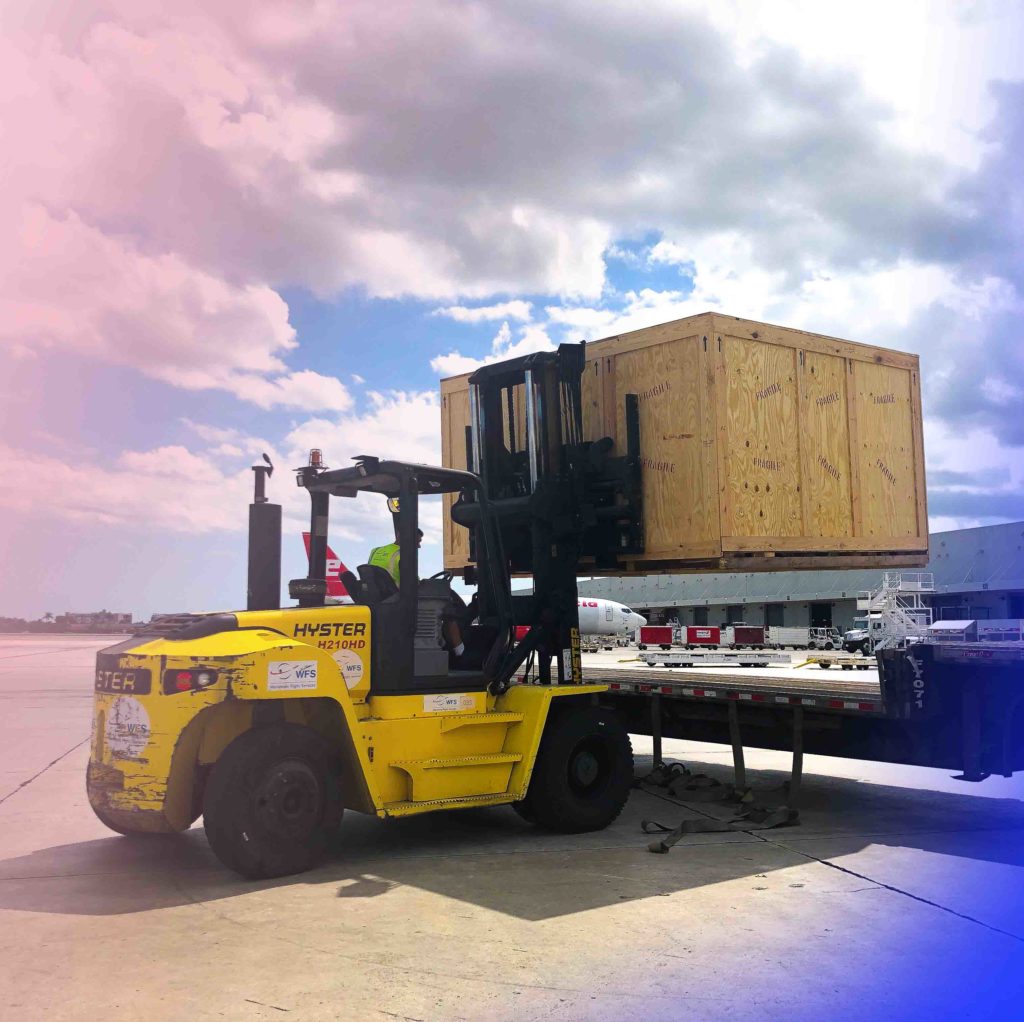How to calculate the chargeable weight for international freight?
If you need international shipping for your business, your business plan must include the costs of transportation. Transportation costs are a critical business concern. Entrepreneurs must take steps to ensure that their shipping costs are as low as possible to keep a high margin. It will also have an impact on whether they choose an ocean liner or a flight.
To make the right decision, you must understand the gross weight and total volume of the cargo in order to calculate the transportation cost.
Each transportation mode, container vessel, truck, and aircraft have limited space and weight. The transportation industry has developed a pricing technique to sell more efficiently the limited capacity; The chargeable weight.
The Chargeable weight uses a weight estimate called the volumetric weight to compare it to the actual gross weight of the cargo. The amount the biggest; the actual (gross weight) weight or volumetric weight will be the chargeable weight. International logistics companies will use the Chargeable weight when they calculate their freight offers
Why Logistics companies use Chargeable weight when calculating costs?
Certain goods weigh more than others. Marble is a heavyweight and takes limited space. Other goods like Fiberglass are light but occupy tons of space in the transport vehicle.
1 cubic meter of marble weighs around 2500kgs. You can reach the gross weight limit of a 40ft dry container by loading around 9 cubic meters of marble.
Loading efficiency in terms of volume; 9cbm/ 67 cbm 40ft container volume =13 %
Fiberglass for insulation is a lightweight commodity. 1 cubic meter weighs around 80kgs. You can fill the 40ft dry container by loading around 5360 kgs of fiberglass insulation.
Loading efficiency in terms of weight: 5360 kgs fiberglass insulation weight / 22000 kgs loading limit for 40ft container = 24%
As you can see, using either weight or volume as a price determinant to calculate the freight costs can be very ineffective for the transport companies.
Calculate Chargeable weight in air freight.
To determine the chargeable weight in air shipments, you must first calculate the gross weight and the volumetric weight.
Example:
10 packages
Dimensions of each package: 100cmx90cmx80cm
Weight of each package: 100kgs (gross weight)
1. Calculation of the gross weight of the cargo
The gross weight is what the cargo weighs on the scale.
10 packages X 100 Kilos each = 1000kgs.
The total gross weight of our cargo is 1000Kgs
2. Calculation of the volume of the cargo
For air freight, we must calculate the cargo volume in cubic meter to reach the volumetric weight.
Dimensions of one package in centimeter; 100cm x 90cm x 80 cm
Dimensions of one package in meter: 1m x 0,9m x 0,8m
Volume of one package; 1m x 0,9m x 0,8m = 0,72 cbm (cubic meter)
10 packages X 0,72 cbm = 7,2 cbm
Total volume of the cargo = 7,2 cbm
3. Calculation of the volumetric weight of the cargo
You have to multiply the cargo volume with the air shipment volumetric weight constant to reach the volumetric weight.
Air freight transportation mode considers that 167 Kgs = 1 cbm
Air shipment volumetric weight constant = 167 kgs / cbm[/brando_blockquote]
Volumetric Weight= Total volume of the cargo x air shipment volumetric weight constant
Volumetric Weight= 7,2 cbm x 167 kgs/ cbm = 1202,4 kgs
4. Calculation of the chargeable weight of the cargo
You compare the gross weight with the volumetric weight of the cargo. The amount the biggest is the chargeable weight for that shipment.
The gross weight of our cargo is 1000kgs.
The Volumetric Weight of our cargo is 1202,4 kgs.
Volumetric weight is higher than the actual gross weight. The chargeable weight in this example is the volumetric weight.
We will use the chargeable weight 1202.4Kgs to calculate our air transportation costs.
Calculate Chargeable weight in Sea freight.
We will use the same method to calculate the chargeable weight in sea shipments. However, Sea shipment volumetric weight constant is different than air shipment volumetric weight constant.
Example:
10 packages
Dimensions of each package: 120cmx100cmx150cm
Weight of each package: 800kgs/gross weight
1.Calculation of the gross weight of the cargo
The gross weight is the cargo weight on the scale.
10 packages X 800 Kilos each = 8000kgs.
The total gross weight of our cargo is 8000Kgs.
2. Calculation of the volume of the cargo
Dimensions of one package in centimeter => 120cmx100cmx150cm
Dimensions of one package in meter => 1,2m x 1m x 1,5m
Volume of one package = 1,2m x 1m x 1,5m = 1,8 cbm (cubic meter)
Total volume of the cargo = 10 x 1,8 cbm = 18 cbm
3. Calculation of the volumetric weight of the cargo
You multiply the cargo volume with sea shipment volumetric weight constant to reach the volumetric weight.
Sea freight transportation mode considers that 1000Kgs = 1 cbm
Sea shipment volumetric weight constant = 1000 kgs / cbm[/brando_blockquote]
Volumetric Weight= Total volume of the cargo x sea shipment volumetric weight constant
Volumetric Weight= 18 cbm x 1000 kgs/ cbm = 18000 kgs
4. Calculation of the chargeable weight of the cargo
You compare the gross weight with the volumetric weight of the cargo. The amount the biggest is the chargeable weight for this cargo.
The gross weight of our cargo is 8000kgs.
The volumetric weight of our cargo is 18000 kgs.
Volumetric weight is higher than the actual gross weight. We have to use volumetric weight as our chargeable weight, which is 18000 kgs.
Calculate Chargeable weight in road transportation.
We will use the same method to calculate the volumetric weight for Airfreight and sea freight. However, the road shipment volumetric weight constant is different than Air and Ocean shipment.
Example:
10 packages
Dimensions of each package: 120cmx100cmx180cm
Weight of each package: 960kgs/gross weight
1.Calculation of the gross weight of the cargo
The gross weight is the cargo weight on the scale.
10 packages X 960 Kilos each = 9600kgs.
The total gross weight of our cargo is 9600Kgs.
2.Calculation of the volume of the cargo
Dimensions of one package in centimeter => 120cmx100cmx180cm
Dimensions of one package in meter => 1,2m x 1m x 1,8m
Volume of one package = 1,2m x 1m x 1,8m = 2,16 cbm (cubic meter)
Total volume of the cargo = 10 x 2,16 cbm = 21,6 cbm
3.Calculation of the volumetric weight of the cargo
You multiply the volume of the cargo with road shipment volumetric weight constant to reach the volumetric weight.
Road freight transportation mode considers that 333Kgs = 1 cbm.
Road shipment volumetric weight constant = 333 kgs / cbm[/brando_blockquote]
Volumetric Weight= Total volume of the cargo x road shipment volumetric weight constant
Volumetric Weight= 21,6 cbm x 333 kgs/ cbm = 7192,8 kgs
4.Calculating of the chargeable weight of the cargo
You compare the gross weight with the volumetric weight of the cargo. The amount the biggest is the chargeable weight for this cargo.
The gross weight of our cargo is 9600kgs.
The volumetric weight of our cargo is 7192,8 kgs.
Gross weight is higher than the volumetric weight. The actual gross weight is the chargeable weight. 7192,8 kgs.
Don’t sweat it! fretcot does the calculation for you.
With fretcot, you don’t have to do the freight calculation. Our online shipping tool is simple to use. There is no sign-up, and it takes less than 30 seconds to do a quote. Just enter your shipment information and, it will calculate the costs for you. You can compare Expedited, air freight, and ocean shipping. Do as many quotations as you like. With fretcot, it is easy to quote, book, ship, and track a shipment. Focus on what matters. Our team of experts will take care of the shipping. Let’s quote now.





